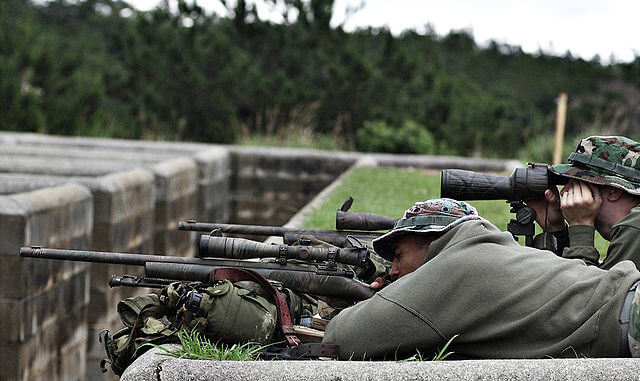What is zero? We all hear about it, but what exactly is it?
It is simply making the bullet’s flight path meet with the cross-hairs at a given distance.
Since we are all professionals and we want to hit our targets, either paper or animal we zero our rifles for a given range. It doesn’t matter what range, just a given range. The rest is simple math and can be done in the field; if you know the drop of the round that you are using. If you’re one of those types of people where it is close enough because you moved a coke can around at 100 yards, don’t read any further. For the rest us, lets continue.
The first thing that has to happen is to have the scope properly mounted to the rifle. That may sound simple but a couple of years ago I was at a public range testing some reloads when I got to noticing the guy beside me. Something about his set up didn’t seem right.
It finally dawned on me that he mounted the scope backwards. For some reason he couldn’t make the rifle hit jack.
So after the scope is mounted correctly, you want to bore sight it. If it is a bolt action, simply steady the rifle and remove the bolt. Look through the bore and place it center of the target. Then without moving the rifle, look through the scope. If they are close, say a thank you prayer. If not, adjust the elevation and windage knobs to make them meet.
Or you could go to your favorite gun store and buy a laser bore sight. Follow the instruction supplied with the device and your set, as far as bore sighting goes anyway. The one that I use goes into the end of the barrel and is recommended for 25 yards.
Using the supplied sighting card I can adjust it up to the 100 yard line. All of this is great as far saving time but it does not relieve us of the responsibility of actually zeroing the rifle to the ammunition we are using.
So let’s go to the range then shall we. For this you will need a few items.
• Targets, preferably one that has been divided into grids
• A steady rest of some type and
• A decent supply of your chosen ammunition
Hang the target at the distance that you want to zero the rifle at. From a steady position, squeeze off one round. Look at the target and make sure you hit it. If so, use the same the aim point and send 2 more rounds down range. If not, move the target closer and try again. If that means you start at 10 yards, then it’s 10 yards.
Once you have a 3 shot group, stop. Take a ruler and measure the distance from the center of the group down or up and then over to the target. For instance, if the group is high and right you will need to measure from the center of the group down to the center of the aim point and the right to the aim point.
For this example we are going to assume that the center of the group is 3 ½ inches right and 5 ¼ inches high.
Now you are going to use the following math formula. Inch (converted to decimal) /(range in yards or meters x .01) = MOA. If you count clicks then finish the formula with MOA x Click (either 2, 4 or 8 clicks per minute) = adjustment. Ok let’s work this through.
3 ½ inches equal 3.5
100 yards x .01 = 1
3.5 / 1 = 3.5 or 3.5 MOA
Dial left 3 ½ minutes or 14 clicks with a ¼” adjustable scope.
5 ¼ inches converted to decimal is 5.25
100 yards x .01 = 1
5.25 / 1 = 5.25 or 5 ¼ MOA
Now dial down 5 ¼ MOA or 21 clicks with a ¼” adjustable scope.
Using the same aim point as before, fire one round, you should hit the center. If so; you know the difference between your left and your right and can do math. The formula works no matter what the distance or inches is. And once it is memorized and used a few times, it’s real easy to do in one’s head.
So now that you are zero at 100, you can use any ballistics program to come up with adjustments for distance based upon your original zero.
Now at this point I must point out 2 things. The first is that this is not my formula, it was taught to me in class and the instructor said that a retired Navy Master Chief who happened to be a SEAL Sniper came up with. So give him credit for his work, if I knew his name would tell you.
Secondly, the formula as presented works wonders but some people have complained that the further out you go it is off. In my testing it is off ½ minute at 500 yards or roughly 2
½” and one minute a 1000 yards or 10”. Either way it is a hit.
Plus it is has been pointed out that the formula is for IPHY (Inch per Hundred Yards) and not true MOA. I must concede on that point. If you want to get technical and make it complicated to the point that you must carry a calculator in the field/range to get a more precise adjustment then use the this formula;
Inch / (range x .01047) = MOA
There you have it a fast and easy way to make sight corrections for both windage and elevation while saving ammunition in the process. A good drop chart taped to you rifle and you are ready to take on any reasonable distance that you are comfortable with.





